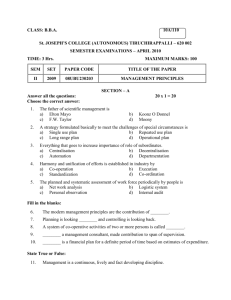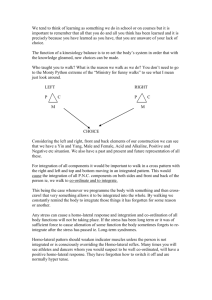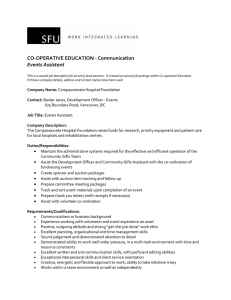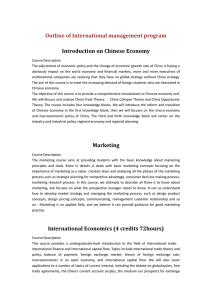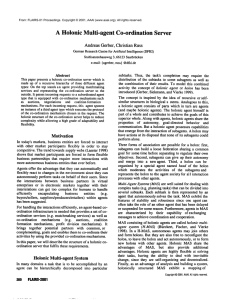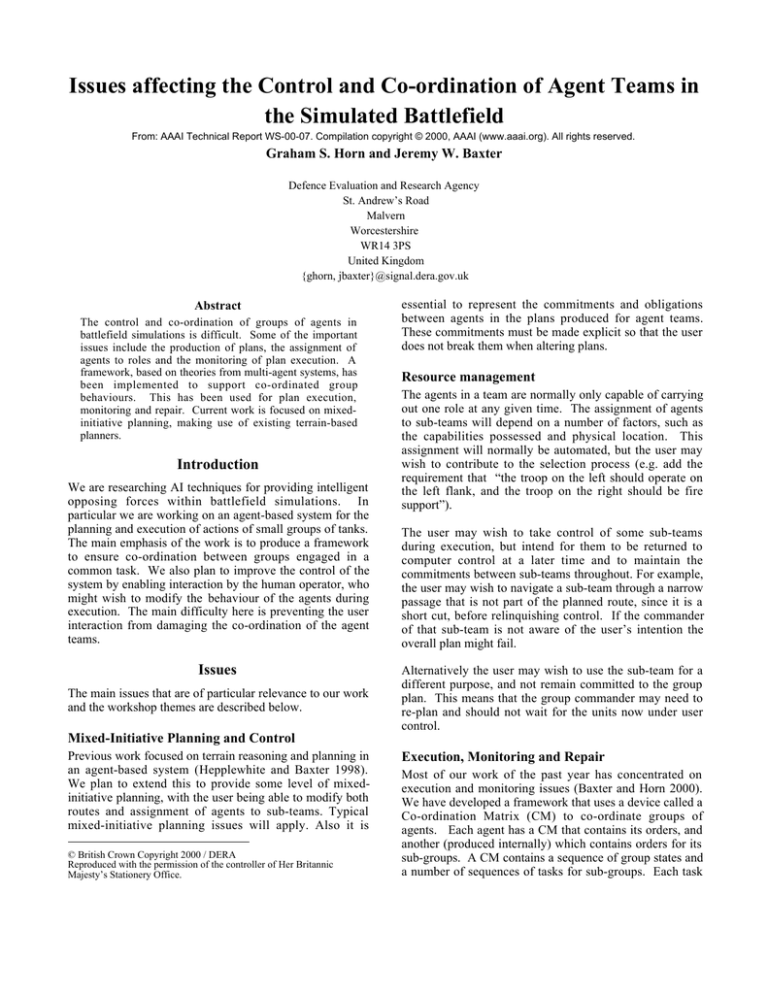
Issues affecting the Control and Co-ordination of Agent Teams in
the Simulated Battlefield
From: AAAI Technical Report WS-00-07. Compilation copyright © 2000, AAAI (www.aaai.org). All rights reserved.
Graham S. Horn and Jeremy W. Baxter
Defence Evaluation and Research Agency
St. Andrew’s Road
Malvern
Worcestershire
WR14 3PS
United Kingdom
{ghorn, jbaxter}@signal.dera.gov.uk
Abstract
The control and co-ordination of groups of agents in
battlefield simulations is difficult. Some of the important
issues include the production of plans, the assignment of
agents to roles and the monitoring of plan execution. A
framework, based on theories from multi-agent systems, has
been implemented to support co-ordinated group
behaviours. This has been used for plan execution,
monitoring and repair. Current work is focused on mixedinitiative planning, making use of existing terrain-based
planners.
Introduction
We are researching AI techniques for providing intelligent
opposing forces within battlefield simulations. In
particular we are working on an agent-based system for the
planning and execution of actions of small groups of tanks.
The main emphasis of the work is to produce a framework
to ensure co-ordination between groups engaged in a
common task. We also plan to improve the control of the
system by enabling interaction by the human operator, who
might wish to modify the behaviour of the agents during
execution. The main difficulty here is preventing the user
interaction from damaging the co-ordination of the agent
teams.
Issues
The main issues that are of particular relevance to our work
and the workshop themes are described below.
essential to represent the commitments and obligations
between agents in the plans produced for agent teams.
These commitments must be made explicit so that the user
does not break them when altering plans.
Resource management
The agents in a team are normally only capable of carrying
out one role at any given time. The assignment of agents
to sub-teams will depend on a number of factors, such as
the capabilities possessed and physical location. This
assignment will normally be automated, but the user may
wish to contribute to the selection process (e.g. add the
requirement that “the troop on the left should operate on
the left flank, and the troop on the right should be fire
support”).
The user may wish to take control of some sub-teams
during execution, but intend for them to be returned to
computer control at a later time and to maintain the
commitments between sub-teams throughout. For example,
the user may wish to navigate a sub-team through a narrow
passage that is not part of the planned route, since it is a
short cut, before relinquishing control. If the commander
of that sub-team is not aware of the user’s intention the
overall plan might fail.
Alternatively the user may wish to use the sub-team for a
different purpose, and not remain committed to the group
plan. This means that the group commander may need to
re-plan and should not wait for the units now under user
control.
Mixed-Initiative Planning and Control
Previous work focused on terrain reasoning and planning in
an agent-based system (Hepplewhite and Baxter 1998).
We plan to extend this to provide some level of mixedinitiative planning, with the user being able to modify both
routes and assignment of agents to sub-teams. Typical
mixed-initiative planning issues will apply. Also it is
© British Crown Copyright 2000 / DERA
Reproduced with the permission of the controller of Her Britannic
Majesty’s Stationery Office.
Execution, Monitoring and Repair
Most of our work of the past year has concentrated on
execution and monitoring issues (Baxter and Horn 2000).
We have developed a framework that uses a device called a
Co-ordination Matrix (CM) to co-ordinate groups of
agents. Each agent has a CM that contains its orders, and
another (produced internally) which contains orders for its
sub-groups. A CM contains a sequence of group states and
a number of sequences of tasks for sub-groups. Each task
contains completion conditions, constraints and
conventions on how to co-ordinate, as well as information
specific to the type of task.
The user of the system may want to look at the internal
state of an agent in order to understand its actions. At
present the user of our system is able to look at the two
current CMs for each agent. The current tasks and states
are highlighted and information on any task or state can be
accessed. However, as the number of agents in the system
grows it is not feasible to display information for each
agent. It might be useful to have an additional agent that
chooses which information should be displayed, in order to
best inform the user of the overall state of the system.
Co-ordination Techniques
The multi-agent systems literature has been studied to
identify how theories of group action can be applied to this
domain. Joint Intentions, as described by Cohen and
Levesque (1990), is a formal model of co-operation that
provides a set of definitions of what it means for a group of
agents to hold a joint goal and to jointly intend to do
something. This model was developed from the BDI agent
model (Rao et al., 1993) which ascribes beliefs, desires and
intentions to agents and uses this to formulate and predict
their behaviour. An agent may have a desire to achieve
something (a goal) but is described as intending to do it
only if it is executing a plan which it believes will achieve
that goal. Cohen and Levesque extend this notion to groups
using the example of two drivers, one of which is
following the other until he knows his way home. They
identify that in order for co-operative behaviour to be
robust it is not sufficient for both agents to mutually
believe1 that they are carrying out an action together, they
need to be committed to keeping the other members of the
group informed about their beliefs and intentions. The key
to avoiding problems is that this commitment persists even
when an individual agent believes the action has been
completed, is impossible or irrelevant.
Ideas from Joint Intentions have been successfully applied
by Tambe to improve the team behaviour of attack
helicopters (Tambe 1998). The main difference between
our framework and the STEAM rules produced by Tambe
is the presence of an agent representing the group as a
whole that is responsible for instructing and co-ordinating
all group members.
The Co-ordination Matrix
The purpose of the Co-ordination Matrix is to provide a
single repository for the information required by a group to
carry out a co-ordinated activity.
The subordinate
members of the group do not have the authority to modify
the tasks that it contains, but are free to re-plan internally
generated tasks. Group members must ensure that beliefs
that affect the Co-ordination Matrix are mutually held.
Moreover, information that does not affect the Coordination Matrix does not need to be shared.
Current Work
Many of the issues described above have yet to be
addressed in our work. We are currently implementing a
mixed-initiative planning system which will be used to
plan a Squadron (US Company) sized assault. The
planners will be based on existing fully automated planners
(Hepplewhite and Baxter 1998) that make extensive use of
terrain reasoning.
N
Initial Squadron
Position
Joint Intentions theory therefore provides a framework
within which groups of agents can hold mutual goals and
execute mutual actions and describes the cases where some
form of communication is necessary to ensure that agents
acting together maintain a coherent state. Jennings (1993)
describes the important role of commitments and
conventions in co-ordination schemes. Commitments are
made by agents to carry out certain actions and they agree
on a set of conventions on how to monitor their
commitments.
High Ground
Low Ground
Enemy Ocupation
Area
Scale
1
Mutual belief means I know that you
know that I know… and so on to an infinite
level of nesting. In practice it is a
requirement that agents are confident that
they all believe the same thing.
0
1
2 Km
Figure 1: Terrain Profile
References
Highly Visible
Concealed
Hepplewhite, R. T. and Baxter, J. W. 1998. Planning and
Search Techniques to Produce Terrain Dependent
Behaviours. In Proceedings of the 7 t h conference on
Computer Generated Forces and Behavioral
Representation, Orlando, Florida.
Baxter, J. W. and Horn, G. S. 2000. Representing and
Executing Group Tasks. In Proceedings of the 9 t h
conference on Computer Generated Forces and Behavioral
Representation, Orlando, Florida. Forthcoming.
Levesque, H., Cohen, P. and Nunes, J. 1990. On Acting
Together. In Proceedings of the Eighth National
Conference on Artificial Intelligence, 94—99.
Figure 2: Visibility from the enemy
The area under consideration is represented in the planners
using grids of costs. These costs will be displayed as
overlays on the map. This aids the understanding of the
user because the options available and their impact can be
displayed in a format s/he is familiar with. Using a
geographically related grid of costs ensures that the
machine reasoning components make decisions clearly
related to the map features accessed by the user.
For example, figure 1 shows the terrain profile of the area
of responsibility for the assaulting squadron. Figure 2
shows an example cost map of the visibility from the
enemy area. The scale represents how well each position
can be observed, lighter points represent positions which
can be seen better and from more positions in the enemy
area. Other costs that will be considered include distance,
gradient and visibility of the objective.
Summary
In order to improve the control and co-ordination of
battlefield simulation agents a number of planning and
execution issues need to be addressed. A framework,
based on co-ordination theories from the multi-agent
systems literature, has been implemented. This is currently
being used to investigate the execution, monitoring, and
repair of plans represented by Co-ordination Matrices. The
production of a mixed-initiative planning system is in the
preliminary stages. User interaction at runtime has yet to
be addressed.
Acknowledgements
This work was funded by Technology Group 5 (Human
Sciences and Synthetic Environments) of the MOD
Corporate Research Programme.
Rao, A., Lucas, A., Morley, D., Selvestrel, M. and Murray,
G. 1993. Agent-oriented architecture for air-combat
simulation. Technical Note 42, Australian Artificial
Intelligence Institute.
Jennings, N. R. 1993. Commitments and conventions: the
foundations of coordination in multi agent systems.
Knowledge Engineering Review, 8(3):223—250.
Tambe, M. 1998. Implementing Agent Teams in Dynamic
Multi-agent Environments. Applied Artificial Intelligence,
vol. 12.


